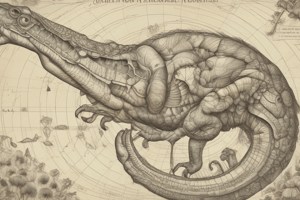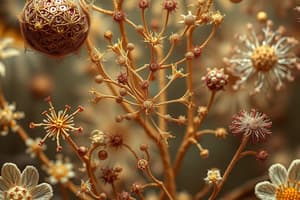Podcast
Questions and Answers
Which of the following is a characteristic that distinguishes bacteria from viruses?
Which of the following is a characteristic that distinguishes bacteria from viruses?
- Ability to replicate within a host cell
- Cellular structure with a defined method of nutrition (correct)
- Inert nature outside of a living host
- Presence of a protein coat surrounding genetic material
How did Pasteur's experiments with the swan-necked flasks contribute to the understanding of the origin of microorganisms?
How did Pasteur's experiments with the swan-necked flasks contribute to the understanding of the origin of microorganisms?
- They proved that microorganisms could spontaneously generate in nutrient-rich environments.
- They supported the belief that life arises from preexisting living cells
- They showed that microorganisms are present in the air and can contaminate sterile solutions. (correct)
- They demonstrated that a 'vital force' was necessary for life to arise from nonliving matter.
A scientist discovers a new unicellular organism in a hot spring. The organism's cell walls lack peptidoglycan, but contain pseudomurein. Based on this information, to which domain does this organism likely belong?
A scientist discovers a new unicellular organism in a hot spring. The organism's cell walls lack peptidoglycan, but contain pseudomurein. Based on this information, to which domain does this organism likely belong?
- Fungi
- Bacteria
- Archaea (correct)
- Eukarya
What is the primary significance of Koch's postulates in microbiology?
What is the primary significance of Koch's postulates in microbiology?
Which of the following characteristics is commonly associated with eukaryotic microorganisms?
Which of the following characteristics is commonly associated with eukaryotic microorganisms?
An emerging infectious disease is identified as having jumped from bats to humans. Which factor contributed MOST to its emergence?
An emerging infectious disease is identified as having jumped from bats to humans. Which factor contributed MOST to its emergence?
How does the use of microorganisms in bioremediation contribute to environmental health?
How does the use of microorganisms in bioremediation contribute to environmental health?
In the binomial system of nomenclature, what does the first name of an organism's scientific name represent?
In the binomial system of nomenclature, what does the first name of an organism's scientific name represent?
Which of the following is an example of how microorganisms contribute to nutrient recycling in ecosystems?
Which of the following is an example of how microorganisms contribute to nutrient recycling in ecosystems?
Why are viruses considered 'inert' outside of a living host cell?
Why are viruses considered 'inert' outside of a living host cell?
Flashcards
Microorganisms (Microbes)
Microorganisms (Microbes)
Organisms too small to be seen with the naked eye; includes bacteria, fungi (yeasts), protozoa, helminths & viruses.
Binomial System of Nomenclature
Binomial System of Nomenclature
A system of naming organisms with two names: Genus (capitalized) and specific species (not capitalized). Both are italicized or underlined.
Prokaryotes
Prokaryotes
Bacteria and Archaea. They are 'pre nucleus'. They do not have membrane bound organelles.
Eukaryotes
Eukaryotes
Signup and view all the flashcards
Viruses
Viruses
Signup and view all the flashcards
Spontaneous Generation
Spontaneous Generation
Signup and view all the flashcards
Germ Theory of Disease
Germ Theory of Disease
Signup and view all the flashcards
Koch's Postulates
Koch's Postulates
Signup and view all the flashcards
Antibiotics
Antibiotics
Signup and view all the flashcards
Normal Microbiota
Normal Microbiota
Signup and view all the flashcards
Study Notes
Humans and the Microbial World
- Microorganisms are too small to see with the naked eye and include bacteria, fungi, protozoa, helminths, and viruses.
- Microorganisms are the foundation for all life on Earth
- Microorganisms have existed for approximately 3.5 billion years
- Plants, animals, and modern microorganisms all evolved from ancestral bacteria
- Human life depends on microorganisms
- Some microorganisms can be pathogenic
- Microorganisms decompose organic waste and recycle nutrients like N, C, S, and P
- Microorganisms can produce chemical products like ethanol, acetone, and vitamins
- They can also produce fermented foods, and products for manufacturing and vaccines
Scientific Names
- Scientific names use the Binomial System of Nomenclature: two words
- The first word is the Genus (capitalized) and the second is the specific species name (not capitalized)
- Genus and species are italicized or underlined
- The Genus may be abbreviated, like E. coli
- Members of a species with minor genetic differences can be indicated with a strain designation
- Informal names that resemble genus names are not italicized, like staphylococci members of the genus Staphylococcus
- After the first use, the genus name may be abbreviated using the first letter only
Types of Microorganisms
- Bacteria
- Archaea
- Fungi (yeasts only)
- Protozoa
- Algae
- Multicellular Helminths (some stages are microscopic)
- Viruses
Differences between the 3 Domains of Life - Table 1.1
- Bacteria are prokaryotic, have peptidoglycan in their cell walls, and can be autotrophs or heterotrophs.
- Archaea are prokaryotic, have pseudomurein in their cell walls, and can be autotrophs or heterotrophs.
- Fungi are eukaryotic, have chitin in their cell walls, and are heterotrophs.
- Protozoa are eukaryotic, have no cell wall and are heterotrophs.
- Algae are eukaryotic, have cellulose in their cell walls, and are autotrophs.
- Helminths are eukaryotic, have no cell wall and are heterotrophs.
- Viruses are acellular and do not have a cell wall.
- Bacteria & archae are all unicellular
- Eukarya cells can be unicellular or multicellular
- Only eukarya have membrane-bound organelles
Prokaryotes & Eukaryotes
- Prokaryotes are "Pre Nucleus"
- Prokaryotes don't have membrane bound organelles
- Prokaryotes are single-celled
- Prokaryotes divide via binary fission and derive nutrition from organic chemicals or by photosynthesis
- Eukaryotes have a distinct nucleus and membrane-bound organelles
- Protozoa do not have a cell wall, absorb or ingest organic chemicals, may be motile via pseudopods, cilia, or flagella and can be free-living or parasitic
- Helminths are multicellular animals and parasitic flatworms (flukes & tapeworms) and roundworms
Viruses
- Viruses are acellular and consist of a DNA or RNA core surrounded by a protein coat
- Viruses may be enclosed in a lipid envelope
- Viruses are replicated only when they are in a living host cell
- Nucleic acid genome(DNA or RNA) is packaged in a protein coat
- Viruses are obligate intracellular agents, they multiply using host cell machinery and nutrients
- All forms of life can be infected by different types of viruses
- Viruses may kill host cell
- Viruses may remain within the host cell and replicate viral genetic information as the host cell multiplies
A Brief History of Microbiology
- The first microbes were documented by Anton van Leeuwenhoek, he made a simple magnifying glass, studied lake water, and observed 'animalcules'.
- Leeuwenhoek's discovery gave proof of life to “invisible creatures” and posed the question of where did they come from?
- Spontaneous generation led to the question "Can life arise from non-living matter?"
Debate over Spontaneous Generation
- Spontaneous generation is the hypothesis that life arises from nonliving matter
- An opposing hypothesis states that living cells arise only from preexisting living cells
- In 1861, Pasteur used S-shaped flasks to disprove spontaneous generation by boiling broth in flasks that showed no signs of life and prevented microorganisms from entering
- Microorganisms originate in air or fluids, not mystical forces
- Pasteur showed that microbes are everywhere and disproved spontaneous generation
- Pasteur took the issue from being philosophical into the realm of testable hypotheses and application of the Scientific Method
- Pasteur's work laid the foundation for the development of aseptic techniques
- Pasteur was also instrumental in associating microbes with the spoilage of food and developed pasteurization
- The germ theory i.e., microbes could be responsible for disease came about
Robert Koch
- Robert Koch offered evidence of what is now known as the germ theory of disease and showed Bacillus anthracis causes anthrax and later worked on tuberculosis
- Koch formalized criteria for establishing a microbial cause of disease, now known as Koch's postulates
Joseph Lister and Edward Jenner
- Joseph Lister revolutionized surgery by introducing methods to reduce wound infection and applied carbolic acid (phenol) as a disinfectant and improved methods via sterilizing instruments and maintaining a clean operating environment
- Edward Jenner observed that milkmaids were protected from smallpox and tested whether prior exposure conferred protection, he took cowpox blister exudate and added it to an 8-year-old volunteer, who did not develop smallpox when exposed to the smallpox virus.
- Jenner's experiment showed that vaccination can provide protection against an infectious disease
Paul Ehrlich & Alexander Fleming
- Paul Ehrlich searched for a “magic bullet” that would kill microbial pathogens without harming the human host and tested arsenic compounds to treat syphilis
- Alexander Fleming identified a compound secreted by the mold, Penicillum, which is toxic to Staphylococcus and purified compounds to develop penicillin for clinical use
Definitions & their relevance to Microbiology
- Immunology studies immunity and the immune system's role in defense against infection
- Biotechnology is the industrial application of microbes, cells, or cell components to make useful products
- Mycology the scientific study of fungi.
- Parasitology studies parasites, their hosts, and the relationship between them.
- Bioremediation uses microorganisms to break down environmental pollutants
- Bacteriology studies the morphology, ecology, and biochemistry of bacteria
- Virology studies viruses and their related aspects
Commercial Benefits of Microorganisms
- Biotechnology uses microbiological and biochemical techniques to solve practical problems
- Vaccine production results by genetically engineered microbes
Microbiological Definitions Contd.
- Antimicrobial drug resistance: is a major health crisis because of the overuse and misuse of drugs
- Normal microbiota colonizes the body without causing disease and microbes reside normally in the bodies of humans
The Human Microbiome
- The Human Microbiome Project characterized microbial communities that inhabit the human body
- Less than 1% of microbes can be cultured and are being characterized by DNA sequencing
- Normal Microbiota play an essential role in human health to prevent diseases
- They aid in digestion and promote the development of the immune system and may decrease allergies, asthma
Emerging Infectious Disease (EID)
- An infectious disease which is new or changing and is increasing or has the potential to increase in incidence in the near future
- Disease agents evolve and infect new hosts
- COVID-19 arose from a strain of the virus that infects bats and can cause different types of damage to the host, like E. coli O104:H4
- Diseases such as malaria and cholera have largely been eliminated from developed countries, but still exist around the globe
- Mobile populations can carry pathogens around globe
Studying That Suits You
Use AI to generate personalized quizzes and flashcards to suit your learning preferences.
Related Documents
Description
Explore the world of microorganisms, including their role in life, decomposition, and nutrient cycling. Learn about scientific names and the Binomial System of Nomenclature.




